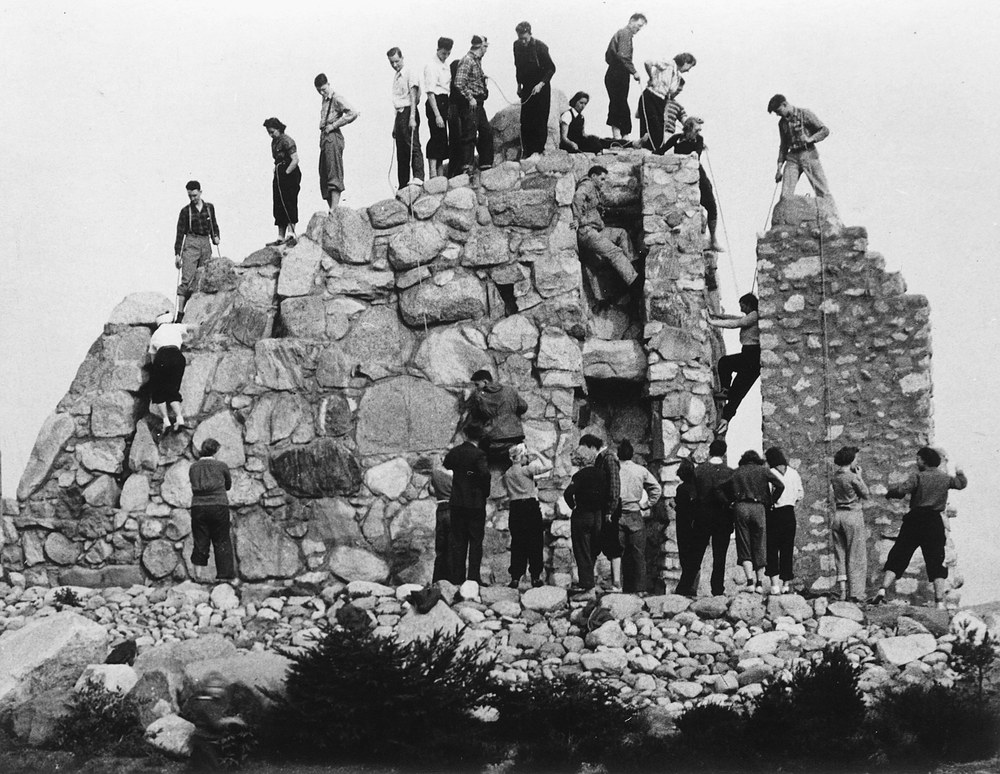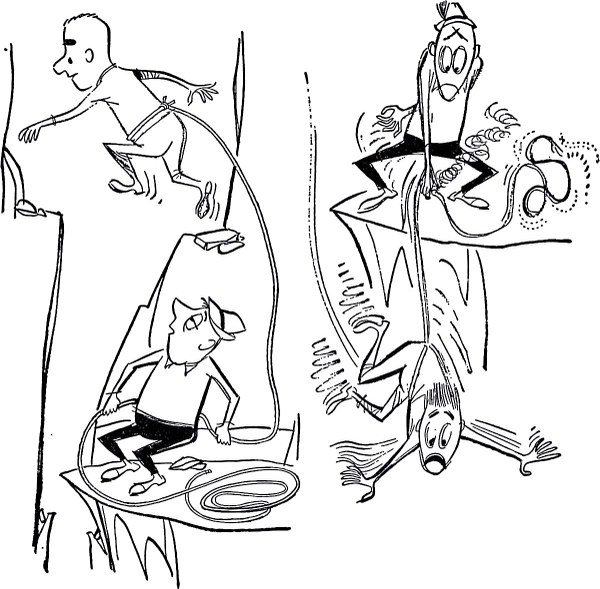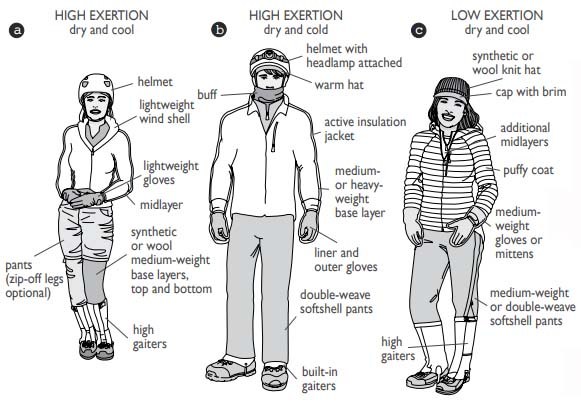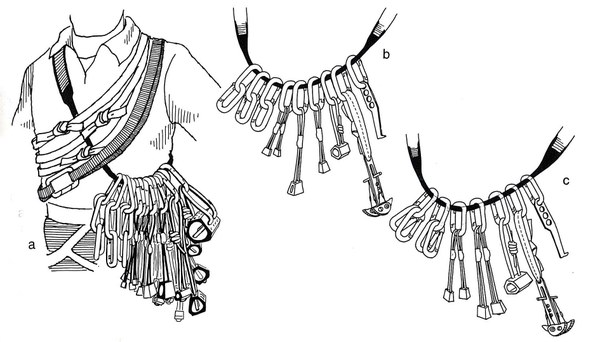
In 1934, a group of aspiring Seattle peak baggers lined the railings of the Rialto Building to watch a young University of Washington student named Wolf Bauer rappel three stories down the central shaft. The maneuver was one of several climbing techniques Wolf had taught himself using materials solicited from family ties in Germany. In lieu of a belay device or climbing harness, neither of which had been invented, Wolf ran two lines of rope between his legs, around one thigh, up and across his chest, over his shoulder, and down his back.
The arrangement attached him to the system (for the most part) and introduced enough friction into the rope to control his descent (as long as his break hand didn’t falter). As Bauer said, “The marble slab was all laid out for me at the bottom in case anything happened.”
Wolf admitted he was “scared as hell going down that thing,” but his feet met the marble floor softly, much to the admiration of his onlookers. The technique – called the dulfersitz rappel – would be one of many mastered by Wolf and his cohort in the years to come. Together, they formed the first Mountaineers’ climbing course in 1935.
Although The Mountaineers had existed as a club since 1906 with many impressive summits to its name, the climbing course represented a new breed looking to go lighter, faster, farther, and higher into the seemingly endless peaks surrounding Seattle.
As it turned out, their careful study of ice ax arrests, piton placements, and hip belays wasn’t just revolutionizing The Mountaineers – it was setting the standard for mountaineering in North America and laying the foundation for a legacy that would span the globe.
In 1939, the climbing course instructors compiled their lecture outlines, an exercise that led to the first book in the nation dedicated solely to climbing education. They called it the Climbers Notebook. Its knots, gear recommendations, techniques, and timeless advice such as “be as discriminating in your choice of climbing companions as you are in selecting your outfit” had been battle tested on first ascents of Mount Goode, Mount Challenger, and Spire Point. And its teaching methods had been solidified through the climbing course, which had grown to a hundred students.
Seattle’s Superior Publishing Company bought the rights and republished the book as the Mountaineers Handbook in 1948. By 1954, the book was nearly out of print, and advancements in climbing meant it was due for a major revision. Harvey Manning, a talented writer and passionate climber and club member, was tasked with the job.
What followed was a 412-page comprehensive guide to alpine climbing called Mountaineering: The Freedom of the Hills published in 1960. The product of dozens of volunteers and countless hours of work, the book gained notoriety outside the club, blowing through the 5,000 copies originally printed. The success paved the way for The Mountaineers to publish other titles, eventually leading to the establishment of Mountaineers Books, the professional publishing house we know today.
The ninth edition of Freedom, released in 2017, represents the latest in a series that has sold 720,000 copies and has been published in a dozen languages. Still written by Mountaineers volunteers, Freedom comprises the course material for people as far away as the Philippines Mountaineering Club, carries the moniker “the bible of mountaineering,” and is the book that everyone from Jim Whittaker to Rick Ridgeway to Kit DesLauriers credits as their gateway into the mountains.
The Art of Freedom
Now a Mountaineers’ board member, course instructor, and major contributor to Freedom 9, Steve McClure grew up flipping through his family’s copy of Freedom 2 and dreaming of adventures in the alpine. To this day, every time Steve teaches self-arrest, Bob Cram’s cartoon from Freedom 2 is stamped in his mind. He recalls, “There’s that one picture where the guy’s expression is ‘whoa, I just barely stopped in time.’ That one has always stayed with me.”
A beloved Seattle artist, weatherman, and Mountaineers member, Bob was behind the human figure illustrations, and his unique cartoon style became a signature of the earlier editions.
In Freedom 5, The Mountaineers continued to use Bob, but moved to realistic illustrations in order to more precisely render techniques. The overhaul required staging hundreds of photos for Bob to work from.
Marge Mueller, who served as the Art Director at Mountaineers Books, orchestrated the new illustrations for Freedom 5. She remembers a particular hollow core door she’d prop up at an incline for climbers to simulate techniques on. In the case of maneuvers like self-arrest, Marge laughed that the door lacked the sliding properties of snow, so models were forced to wriggle around on their stomachs and backs to stage each shot.
Operating out of The Mountaineers’ old program center in Queen Anne, Marge recalls, “There were so many illustrations with so many parts, and each illustration had to mesh with a particular text. We staged all of it with the hollow core door or ladders or hanging off the balcony.”
Marge worked with Mountaineers volunteers to make sure each depiction was just right, a process that required trading hundreds of drafts back and forth, working with typesetters, and laying out paste boards by hand. Through persistence, the project moved from the hollow core door to the detailed renderings of Freedom 5 – illustrations that went on to be studied by climbers around the world.
From edition to edition, the illustrations reveal an evolution in artistic style and a revolution in mountaineering technique and technology. Freedom 9 features all-new, vectored illustrations, allowing even more detail – an overhaul that, like Freedom 5, demanded copious amounts of time. That Freedom continues to be the go-to book on climbing is a testament to the ethos that inspired Wolf’s rappel and Marge’s tireless work. Behind each update are Mountaineers challenging themselves to study, refine, and share their craft.
Belay
How do you belay without a harness or device? Carefully! Freedom 1 advises the belayer “torture himself with a mental picture of the fall and all its consequences to the climber, the belayer and the rope.” As seen in Freedom 4, the figures have harnesses (there’s information on commercial and homemade options), but hip belays are still the prominent technique (belay devices are presented as a viable method, but the models at the time made the process somewhat cumbersome). Freedom 9 includes revamped belay instructions aligned with the American Alpine Club’s nationwide universal belay standard.

 Belay illustration, Freedom 1, 1960
Belay illustration, Freedom 1, 1960
Clothes
Freedom 6’s cast of character got a major makeover in Freedom 9. A meeting with Outdoor Research inspired Steve McClure, who authored the updates, to think of clothing in three dimensions: exertion, temperature, and precipitation. Things have come a long way since the Mountaineers Handbook, which contains detailed instructions for nailing boots and recommends a pull over parka due the propensity of zippers to break.

 Clothing illustration, Freedom 9, 2017
Clothing illustration, Freedom 9, 2017
Rock Protection
In the 1970s, “clean climbing” transformed the techniques and equipment used on rock. Removable nuts, chocks, and springloaded cams replaced rock scarring pitons, allowing climbers to protect themselves with greater ease and reduce their environmental impact. By the time Freedom 5 was published, climbers carried a radically different arsenal than the hammers and pitons seen in Freedom 1.
 Rock Protection illustration, Freedom 5, 1992
Rock Protection illustration, Freedom 5, 1992
Ten Essentials
First aid kits are part of the now famous Ten Essentials, introduced by Harvey Manning in Freedom 3. To this day, everyone from REI to the Appalachian Mountain Club uses the list as a baseline for what to pack. In Freedom 9, Steve McClure says, he ventured to update the “sacred scrolls that came down from Harvey Manning.” The revision included revamping navigation to expand on electronics like GPS and reorganizing items into two categories: addressing emergencies and preparing to safely spend the night.
Onwards
In the preface to Freedom 3, Harvey Manning reflects on the book’s evolution, writing about gear advancements “that would have amazed climbers of the 1940s as much as the suggestion they would live to see man on the Moon” and young athletes advancing the “capabilities of the human body almost to those of monkeys and spiders.” Due to increased visitors to the backcountry, he also remarks on the need for “a reinforced commitment to preserving the wilderness environment.”
The ever-changing nature of climbing rings as true today as when Harvey wrote about it in 1974. So how has Freedom managed to stay relevant? Freedom 9 contributor Steve McClure explains, “The fact that it’s not written by an author makes the whole thing possible. It’s about all the students and all the leaders across our community contributing to this body of knowledge.”
Freedom 9 takes collaboration one step further with more input from outside mountaineering experts than ever before. Contributors worked with the American Institute of Avalanche Research and Education, American Mountain Guides Association, Access Fund, and more. Helen Cherulllo at Books says, “It’s part an ongoing commitment to do everything possible to ensure Freedom continues to be the bible of mountaineering.”
For Eric Linxweiler, the coeditor of Freedom 9, working on the book is the greatest honor he’s had at The Mountaineers. “Freedom goes out and finds people and get them to go places they wouldn’t have otherwise gone.” says Eric, “That’s just an amazingly powerful thing. When you look at Freedom, you should really look at this as a representation of our entire organization going back a hundred years. So if you’re a student, if you’re instructor, if you’re a trip leader, if you’re a staff member – you should take pride that this represents you. What we teach people here is being taught all over the world.”
As for Freedom 10?
Eric says, “The work is already underway.”
This article originally appeared in our Winter 2018 issue of Mountaineer magazine. To view the original article in magazine form and read more stories from our publication, click here.
 Peter Dunau
Peter Dunau